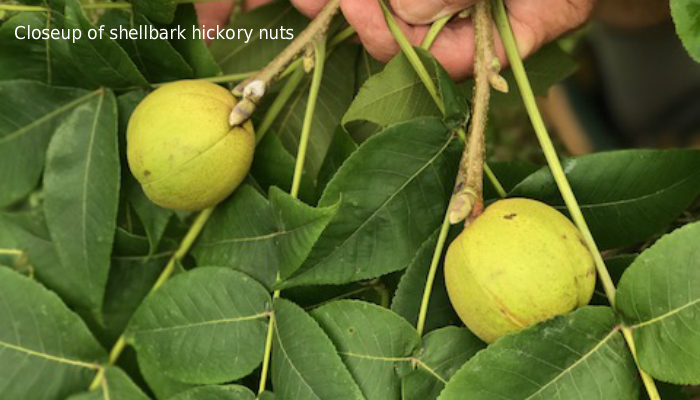Shellbark Hickory, The Tree That Used To Be

Today almost all hickory trees in Johnson County live on the uplands. You probably know them well – shagbark, bitternut, mockernut, maybe occasionally pignut. But once upon a time there was also a floodplain species, the shellbark hickory. It was a little picky about its requirements, needing a lot of water and yet reasonably good drainage for its roots. The lower floodplain of the Iowa River and its larger tributaries met this requirement, often having around five feet of silt with good water-holding capacity, over river sands, which provided drainage and aeration.
Unfortunately for shellbark hickory, these conditions made this same land ideal for the White pioneer bent on growing crops, with the annual spring flood for extra nutrients and moisture, yet drying out on top early enough to get seed in the ground. In addition, the shellbark was the largest and straightest of the hickories, a tough wood in great demand back then for implements, wagon hubs, and uses that required shock resistance, like tool handles. So this tree was often logged out of the floodplains even before land clearing for agriculture got under way. Further contributing to its demise were its unusually large, sweet, meaty nuts, which provided another common name – kingnut (a king-sized nut). Humans competing with squirrels assured that even the few surviving trees had no opportunity to reproduce. In his 1896 listing of trees of Johnson County, Macbride mentions that a single specimen of shellbark existed “near Iowa City.” His unusually vague reference suggests that perhaps the professor didn’t want its exact location advertised.
Of all the hickories, shellbark had the misfortune of having its distribution coincide most closely with the “corn belt,” so its fate elsewhere in the nation largely parallels that in Johnson County. Peattie’s A Natural History of Trees noted in 1948 that its wood was still considered distinctly valuable, and that while “the literature of our vanished midland frontier has passed it by, the operators of portable sawmills still search it out, with a knowing eye.” Because its population has been so sparse and thinly distributed for more than a century, the people who still recognize it all use different local names, which also include bottom hickory, bigleaf shellbark, big shellbark hickory, western shellbark hickory, May hickory, and thick shellbark hickory. Its older scientific names are also a bit confusing. Although Carya lacinosa is its present official name, in the older literature it is also Carya sulcate, Hicora lacinosa, and Hicora sulcate. Just to make it more interesting, east of Iowa there are also several other floodplain hickory species, which not only shared the shellbark’s fate but also share some of its common names. But here in Iowa, if you find a floodplain hickory with bark less shaggy than shagbark, and it has very large leaves and nuts, it’s probably shellbark. Van der Linden and Farrar’s Forest and Shade Trees of Iowa mentions that although “it has become rare in most places…it is still fairly common along the Chariton River downstream from Lake Rathbun.”

I wrote this report in the summer of 1996 for WINGS, the newsletter of the Johnson County Songbird Project. Months later a little package arrived in the mail. A friend had been squirrel hunting in south-central Iowa and found himself looking up into a hickory with large leaves, and nuts that seemed as big as tennis balls. So he sent me a sample. With some early TLC in the form of hardware cloth to keep the rodents foiled, today I have four of these trees at home, probably close enough to cross-pollinate. The first few nuts appeared this summer, which I harvested early for the attached photo, and in order to beat the squirrels.
I’ve found that even in a small yard, anyone can replace lawn with an uncommon native tree or shrub, or a patch of prairie flowers, and thereby add a bit of habitat for some bird or butterfly. There are some great nursery catalogues out there, which not only sell natives, but also list their requirements, so you can match up species adapted to your yard or acreage.
Tags: Lon Drake, native gardening, native species, shellbark hickory

